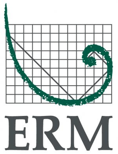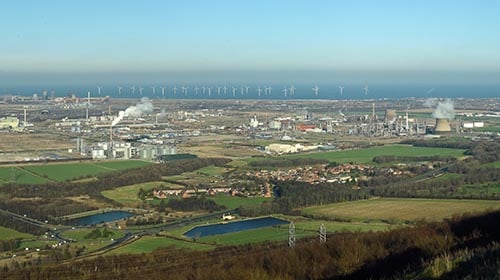Sustainable consumption
Sustainability means better livelihoods
ERM helps organizations balance profitable growth with sustainable growth by helping them transform their operations and products to deliver better outcomes while mitigating the risks associated with environmental and social issues.
We work with companies to reduce waste and use less energy and water, without compromising – and in fact generating – business value.
Smarter use of the planet’s resources
Across the life cycle of assets and products, ERM provides services so our clients can be successful while making smarter use of the planet’s resources.
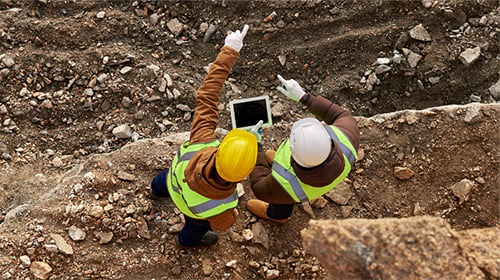
Sustainable mining and building “the mine we want to see”
ERM works with mining companies around the world to help address technical challenges, from safety and water management to social performance and mine closure. We understand the tension of having to provide important commodities to society without causing harm, and accomplishing this in an economically viable way.
Building on our insights, we are convening conversations to help the sector think about the notion of “the mine we want to see” – and what it will entail to get there.
Ahead of this year’s Prospectors and Developers Association of Canada (PDAC) Convention, ERM published a document to stimulate a conversation with the sector on what the future of sustainable mining needs to look like. We convened a panel at the convention with leading companies to explore this topic further. Our panelists shared how today’s mining companies need to continually innovate, act and adapt – not just to compete, but to survive.
By putting sustainability at the heart of their change agenda, mining companies can address the risks and challenges facing their business and seize the opportunities presented by a digital age.
ERM has supported businesses globally with their major capital projects for more than 40 years. Our goal is to enable our clients to secure financing, obtain host country approvals, drive social performance and to construct, operate and retire their projects sustainably, on schedule, and on budget. In the face of critical sustainability challenges, our clients rely on our ability to assist them in functioning more effectively and sustainably.
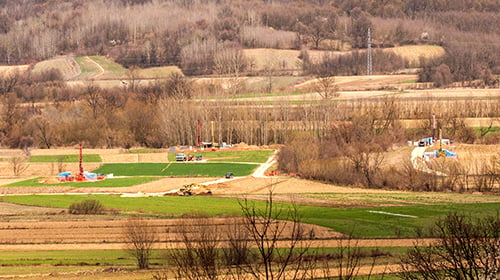
Helping Rio Tinto prepare for the opening of a mine and processing plant for a new and unique lithium-borate mineral jadarite
Within the scope of ESIA preparation, ERM is providing a wide range of services including extensive and detailed baseline studies, options assessment and engineering-collaboration, Serbian regulatory advice, stakeholder engagement planning, hazardous materials classification, land acquisition advice and specific in-country presence. By combining our global ESIA and permitting experience with a bespoke team of Serbian experts, ERM is helping the client progress through different study phases.
Assessing impacts across the product life cycle
Given the pressures of the growing middle classes on society and the planet, there is growing demand for innovative products and services to address complex issues such as climate change, access to water and plastics in the environment. Yet even “green” decisions bring with them complex consequences across the product life cycle.
Through life cycle assessment (LCA) studies, ERM can assist clients in early identification of risks and opportunities in their operations and maximize business value. LCAs can be done across the full value chain of operations (cradle-to-grave), from the production and processing of raw materials, through manufacture, use, reuse and end of life. Issues commonly appraised include carbon, resource, water, and toxicity footprints. Increasingly, social metrics such as human rights, health and safety are also considered in these studies.

Life cycle dataset for the cobalt industry
This new cobalt LCI/LCA dataset will help LCA practitioners to meet data needs in the battery, automotive and other sectors – which depend on cobalt to help power the low carbon economy of the future.
ERM conducted a peer-reviewed life cycle assessment (LCA) with participation from eight major cobalt producers, who produce cobalt as a by-product from either nickel or copper production.The new dataset has been used as part of the EU Product Environmental Footprint Pilot on rechargeable batteries, and has been incorporated into LCA databases. Work is underway to incorporate the new cobalt data into other studies as well.
This project provided an up-to-date representative dataset for cobalt to support manufacturers and downstream users in their efforts to improve the environmental performance of their cobalt-containing products.
LCA studies can inform decisions on cost reductions, reduce business risks, enhance a company’s or product’s reputation, improve environmental management and procurement, enable credible environmental claims and product declarations, and support development of sustainable products and services.
Life cycle assessments for a confidential client
We provided the client with a cradle-to-gate streamlined LCA study that estimated the environmental impact profile of the products. The impact profile included GHG emissions, ozone depletion, human toxicity, non-cancer effects, particulate matter, photochemical ozone formation (VOCs), acidification, freshwater eutrophication, marine eutrophication, freshwater ecotoxicity, land use and water resource depletion. This study provided valuable information about priority issues during key stages of the product life cycle.
Protecting brands through product stewardship
ERM helps companies create business value through sustainable product design; procurement and raw material management; clear understanding of health and environmental impacts in the manufacture, use and disposal of products; and effective engagement with customers, consumers and other stakeholders.
We work with companies to address gaps in product stewardship that can result in product impoundment or recall, which can disrupt supply chains, increase costs, and damage brand and reputation. We aim to identify and mitigate these risks while looking beyond them to support product innovation and brand differentiators that have the potential to contribute to the bottom line.

Helping clients meet REACH deadline
ERM scaled up quickly to deliver for our clients with this highly specialized service. We helped clients stay in business by ensuring they met this critical regulatory requirement.
ERM combines the product safety and EHS perspectives. With our holistic lifecycle view on substance use and the local presence in all global markets, we identify best marketability options for products and prevent negative surprises.
ReachCentrum, an ERM Group company specializing in REACH regulation and a market leader for REACH consortia management, established a dedicated program to support companies in the various steps of registration and co-registration, in particular in providing letters of access (for the data required) and in supporting dossier preparation and dossier application to ECHA, the European Chemical Agency. ReachCentrum automatized its approach, helping clients mitigate the burden of registration in a time- and cost-effective way.
The acquisition of ReachCentrum by ERM provided a strategic perspective to its staff, who now support clients beyond the European Union with consortia management, financial management and data-sharing services. We see the need for ReachCentrum services strongly evolving in areas such as Turkey, Taiwan and Korea.
Integrating sustainability across the supply chain
Focusing on a company’s sustainability impacts is a priority for efficiency, cost savings and revenue growth. Yet the impacts of any organization’s supply chain can be significantly greater than its direct impacts. A less robust supplier engagement program can leave businesses open to environmental, financial, regulatory and reputational risks and liabilities, and potential interruption to business-critical supply chain processes. There are also missed opportunities to leverage efficiencies from a high-performing and more sustainable supply chain.
Sustainable supply chain management for India-based multinational companies
The training modules encompassed the key components of the sustainable supply chain process:
- Review internal process and support in place and assign responsibilities to lead;
- Map the supply chain and identify highest risk areas;
- Establish sustainability criteria for selection, evaluation and monitoring, applying relevant industry standards;
- Evaluate suppliers and engage to influence improvements;
- Integrate results of evaluation into sourcing decisions using balanced scorecard and alignment of internal buying incentives; and
- Ongoing monitoring, engaging, rewarding, reporting and working responsibly toward sector-wide change.
ERM's training series helped sensitize multi-disciplinary stakeholders on the business-critical aspects of integrating sustainability within the supply chain processes.
ERM works with the manufacturers of consumer goods to identify, measure and mitigate their environmental and social impacts. We support our clients in addressing the challenges of sustainability across their supply chains, helping them to improve compliance with regulations and industry standards while meeting the needs of consumers, customers, suppliers and other stakeholders.
Innovative solutions to water management
Water availability and quality is a growing global challenge for many organizations as they struggle to meet regulatory requirements, stem rising costs, reduce impacts and ensure business sustainability.
In addition to helping companies meet regulatory requirements, ERM helps clients ensure the quality and longevity of water resources for both their own needs and those of the wider community. We apply a deep understanding of water issues to help companies improve operations, reduce water use, control costs and ensure compliance.
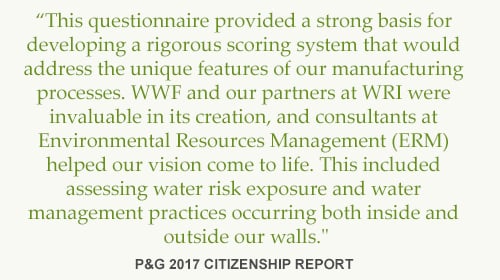
Water risk assessment for P&G
We developed and piloted a detailed questionnaire related to both internal and external risk factors that each site completed, looking at water risk exposure, water management and potential business impact. We evaluated the questionnaire results, incorporating water risk scores from public tools, including World Resources Institute (WRI) Aqueduct Water Risk Atlas and World Wildlife Fund (WWF) Water Filter. Furthermore, WRI and WWF reviewed and provided feedback on ERM’s methodology for assessing water risk inside and outside the four walls of the facility.
Based on our evaluation, ERM prepared detailed site-level reports, along with a summary corporate report, highlighting the key findings and relative scoring to aid in raising awareness and understanding of water risk issues at the site and corporate levels. The results of our work serve as the basis for the next phase in P&G’s water risk assessment framework.
By taking a strategic approach to water management, organizations can ensure continuity of operations in the face of supply challenges, and safeguard reputation and competitive advantage.

Moneta Divide water quality assessment for Aethon Energy
Using powerful computer resources, the most elaborate calibrated water quality model of its kind was created for the Boysen Reservoir and the surrounding tributaries. ERM’s model reproduced observed conditions and made predictions of hypothetical future scenarios. The study spanned a period of more than one year, and was a collaborative effort between Aethon Energy, the Wyoming Department of Environmental Quality and ERM.
This innovative approach resulted in proposed permit levels that enable Aethon Energy to significantly increase production, while complying with applicable antidegradation requirements to protect potential drinking water and aquatic life sources. The model also generated a tool to help Aethon Energy estimate the amount of produced water treatment needed under the varying future conditions to ensure protection of water quality. The study and its outcome were shared with various stakeholders providing assurance that no adverse water quality changes would occur.
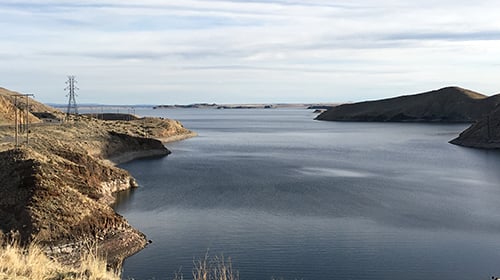
ERM’s thought leadership on water-related issues includes identifying trends and opportunities for collaborative projects that lead to tangible societal benefit. We are involved in developing tools, delivering technical presentations and organizing panels that help companies improve their understanding of water risk and responsible water stewardship.
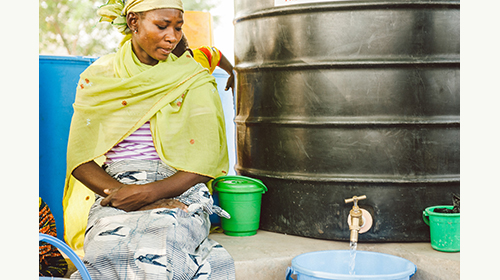
World Water Day highlights - ERM Foundation in action
ERM used Water Day to raise employee awareness of the ways ERM brings strategic and technical know-how to help our clients understand and manage water risks and water sustainability, and to discover more about some of the water, sanitation and hygiene programs being supported by the ERM Foundation.
In Ghana, the ERM Foundation team worked with Saha Global to provide clean drinking water for 2,400 people through the creation of women-owned clean water businesses, empowering women and benefitting local economies. In addition, ERM employees are providing pro bono support to develop a water testing training manual and build a monitoring schedule based on performance data. The project outcomes included reduction of water-related illness and improved community health and sanitation; improved livelihoods for women entrepreneurs; improved water testing procedures and overall water quality.
Protecting people’s lives through safety transformation
Managing health and safety is a core responsibility for every organization. ERM helps companies address safety challenges, delivering immediate reductions in risk and sustained improvements in safety performance.
Global recognition for transformation in safety culture and performance
ERM consultants have also been coaching senior leaders in the organization, middle management and frontline leaders on practical actions they can take to deliver enduring change to the culture, behaviors and safety performance on the frontline.
The culture change program has helped our client to create a more open culture where people feel freer to speak up: there was a four-fold increase in reporting of safety observations since 2016. Trust in leadership is markedly improved. Critically, safety performance is continuing to improve and high-potential incidents are trending downward.
The client team that has been driving the cultural change program with ERM’s support was recognized as the winner in the global organization’s annual safety and environment category. The deeply collaborative engagement with the client is ongoing and continues to deliver great outcomes.
Combining technical expertise in risk, process and occupational safety, human factors, and information systems, with a focus on leadership, culture and behaviors, we work with clients to achieve the full benefit of their safety investment – safeguarding lives, assets and reputation.
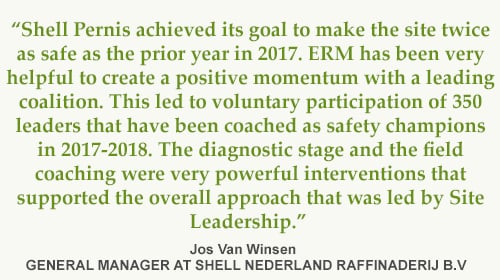
Doubling safety performance for employees and contractors
The goal for 2017, and again in 2018, is to make Pernis two times more safe than the prior year. To achieve this objective, Shell recognized that safety behavior and safety leadership are key drivers of improvement. To kick-start the process, Shell launched an engagement survey with all the employees. This was followed by the introduction of a Safety Excellence program, together with contractors. Shell requested ERM assist them on this journey.
ERM started with a one-week diagnostic assessment. Observing conditions and behaviors in the field and interviews with leaders gave Shell and ERM good insights into root causes and underlying issues. This was followed by a leadership workshop, which created a personal and organization imperative for leaders in the organization to change the current approach.
Coaching leaders in the field enhanced their hazard recognition skills and equipped them with techniques to engage with personnel in a style designed to enact behavioral change. Sustaining the performance improvement included invigorating core safety processes and preparing internal coaches to continue the learning cycle.
ERM works with industry and multi-stakeholder organizations to provide pragmatic and actionable guidance for addressing sustainable development. Increasingly, this involves implementing the SDGs either as standalone programs or integrated into the core business of the company. Given that human factors can be optimized to enhance safety, increase productivity and reduce human error, they play a significant role in achieving each of the SDGs through the formation of effective systems to support human performance and behavioral change.
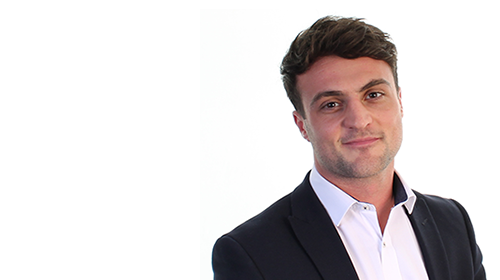
Exploring the role of human factors in achieving the SDGs
The megatrends are shaping numerous segments of the economy and have major implications for businesses. As noted in the article, human factors can aid the debate on climate change by making data accessible and meaningful to its target audience. Digital transformation requires consideration of device usability and effective integration of technology. Human factors can support population growth by aiding cultural change to develop new ways of working and traveling that minimize impact, and it can assist the emerging middle classes by helping to meet their aspirations while encouraging a more responsible attitude towards consumption.
Through driving effective behavior change and better understanding of human needs, human factors are core to successfully addressing the SDGs.


